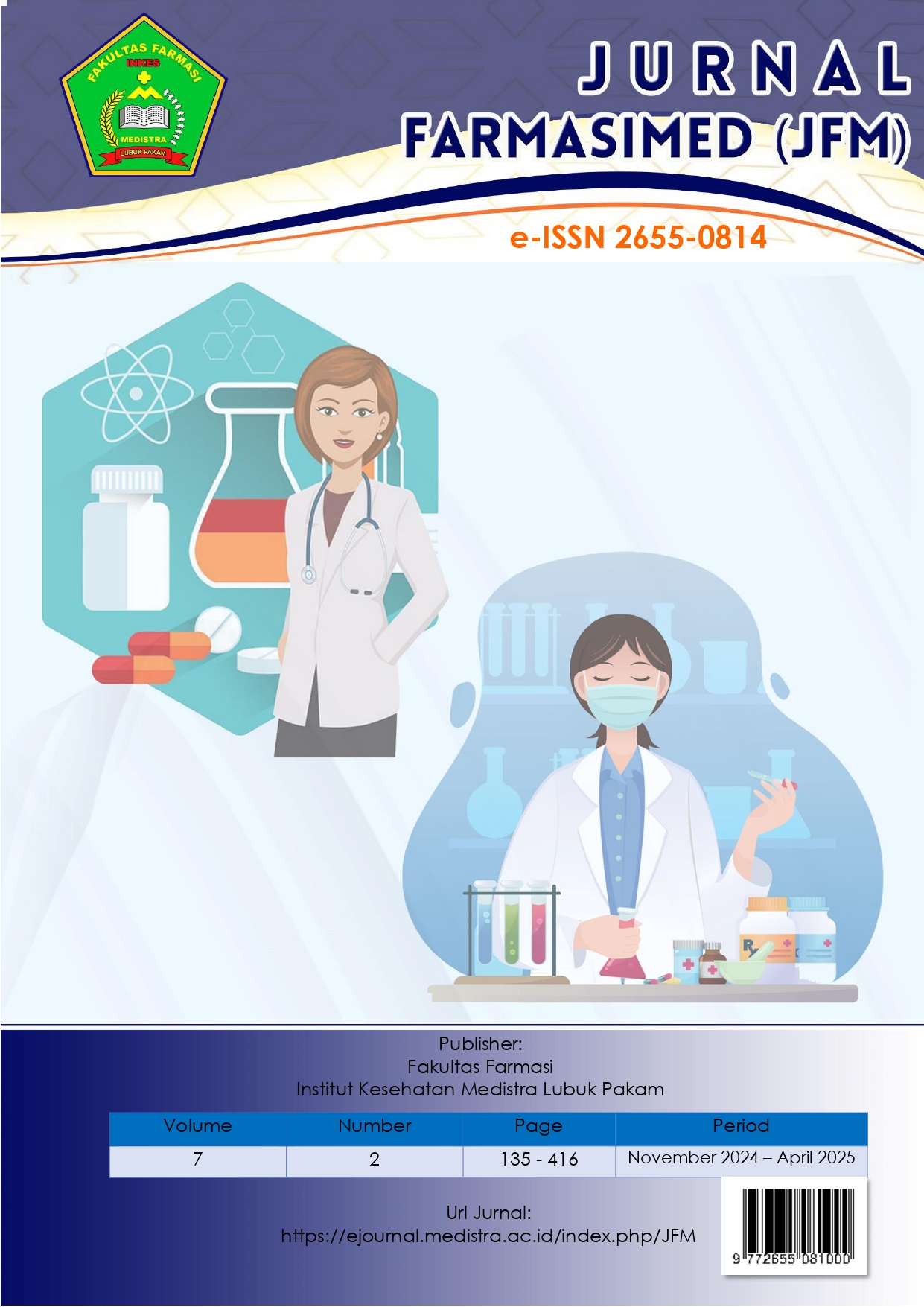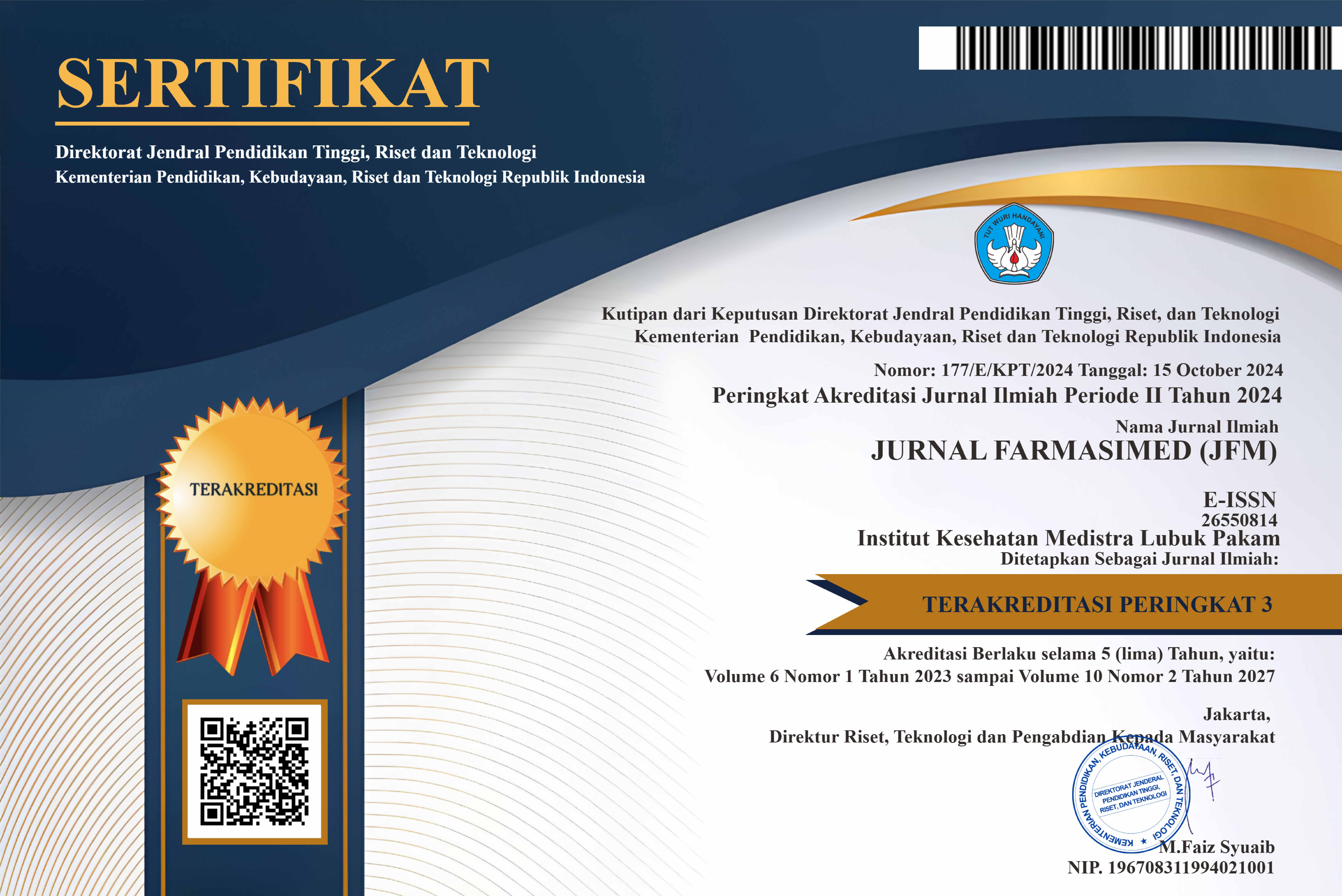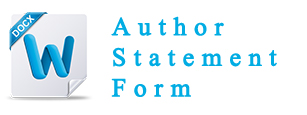Overview of Therapy and Medication Adherence in Outpatient Post-Stroke Patients at RSUD Taman Husada Bontang
DOI:
https://doi.org/10.35451/jfm.v7i2.2585Keywords:
Stroke, Recurrence stroke, Therapeutic profile, Medication AdherenceAbstract
Background: Stroke is a cerebrovascular disease that can cause physical and cognitive impairments, including a high risk of depression. Medication adherence plays a crucial role in preventing complications and improving patients' quality of life. Objective: This study aims to describe the therapy and evaluate medication adherence among post-stroke outpatients in the recurrent and non-recurrent stroke groups at RSUD Taman Husada Kota Bontang. Methods: This study employs a cross-sectional design, involving a total of 152 patients, consisting of 119 non-recurrent stroke patients and 33 recurrent stroke patients. Data were collected through interviews, secondary data retrieval from medical records, and primary data obtained from the MMAS-8 (Morisky Medication Adherence Scale-8) questionnaire to assess medication adherence levels. Data were analyzed descriptively, and a chi-square test was performed to examine the association between medication adherence and stroke recurrence. Results: The findings indicate that both recurrent and non-recurrent stroke groups were prescribed antiplatelet, anticoagulant, neuroprotective, and antihypertensive drugs. Additionally, lower medication adherence was more frequently observed in recurrent stroke patients compared to non-recurrent stroke patients (24% vs. 26%). Analysis of the MMAS-8 questionnaire items revealed that forgetting to take medication occurred in both groups, but was more common among non-recurrent stroke patients (23% vs. 9%). Conclusion: This study highlights the need for continuous monitoring of therapy profiles and efforts to improve medication adherence to prevent further complications in post-stroke patients. The findings emphasize the importance of ongoing evaluation and innovative medication education for post-stroke patients.
Downloads
References
V. L. Feigin et al., “World Stroke Organization (WSO): Global Stroke Fact Sheet 2022,” Int. J. Stroke, vol. 17, no. 1, pp. 18–29, 2022, doi: 10.1177/17474930211065917.
W. Sui and L. H. Wan, “Association Between Patient Activation and Medication Adherence in Patients With Stroke: A Cross-Sectional Study,” Front. Neurol., vol. 12, no. September, pp. 1–12, 2021, doi: 10.3389/fneur.2021.722711.
O. F?rat, E. M. Arsava, C. Togay-Is?kay, M. Basol, M. A. Topcuoglu, and K. Demirkan, “Clinical Pharmacist’s Contribution on Treatment Adherence and Quality of Life in Patients with Stroke: A prospective, controlled, clinical pharmacist led-educational study,” Authorea Prepr., 2021.
I. M. Kronish, M. A. Diefenbach, D. E. Edmondson, L. A. Phillips, K. Fei, and C. R. Horowitz, “Key barriers to medication adherence in survivors of strokes and transient ischemic attacks,” J. Gen. Intern. Med., vol. 28, pp. 675–682, 2013.
C. Ayala, “Use of outpatient rehabilitation among adult stroke survivors—20 states and the District of Columbia, 2013, and four states, 2015,” MMWR. Morb. Mortal. Wkly. Rep., vol. 67, 2018.
D. Edmondson, S. Richardson, J. K. Fausett, L. Falzon, V. J. Howard, and I. M. Kronish, “Prevalence of PTSD in survivors of stroke and transient ischemic attack: a meta-analytic review,” PLoS One, vol. 8, no. 6, p. e66435, 2013.
J. Hewitt, H. F. Azhari, M. O’Neill, A. Smith, T. Quinn, and J. Dawson, “Post-stroke diabetes management: a qualitative study,” Front. Neurol., vol. 15, p. 1364217, 2024.
S. Ruksakulpiwat, Z. Liu, S. Yue, and Y. Fan, “The association among medication beliefs, perception of illness and medication adherence in ischemic stroke patients: a cross-sectional study in China,” Patient Prefer. Adherence, pp. 235–247, 2020.
L. Mellon et al., “Cognitive impairment six months after ischaemic stroke: A profile from the ASPIRE-S study,” BMC Neurol., vol. 15, no. 1, pp. 1–9, 2015, doi: 10.1186/s12883-015-0288-2.
D. F. Sari, “Pengetahuan Dan Sikap Pasien Hipertensi Dengan Tindakan Pencegahan Serangan Stroke Di Rsud Taman Husada Bontang,” vol. 3, no. 4, pp. 1081–1090, 2023.
Martini, F. Andrianur, and Amiruddin, “Pengaruh Pemberian Slow Stroke Back Massage (SSBM) Tterhadap Perubahan Kualitas Tidur Pasien Stroke Iskemik di RSUD Tamna Husada Bontang,” J. Cakrawala Ilm., vol. 3, no. 6, pp. 1747–1756, 2024.
D. Lola, “Hubungan hipertensi dengan kejadian stroke berulang pada penderita pasca stroke,” J. Kesehat. MIDWINERSLION, vol. 5, no. 1, pp. 125–131, 2020.
H. Karuniawati, Z. IkawatI, and A. Gofir, “Pencegahan Sekunder Untuk Menurunkan Kejadian Stroke Berulang Pada Stroke Iskemik,” J. Manaj. dan Pelayanan Farm., vol. 5, no. 1, pp. 14–21, 2015.
R. Syah, “MANAJEMEN KEGAWATDARURATAN HIPERTENSI KRISIS DI FASILITAS KESEHATAN PRIMER?: TANTANGAN DAN SOLUSI Management of Hypertensive Crisis Emergencies in Primary Healthcare Facilities?: Challenges and Solutions to prevent serious complications , such as stroke a,” J. Farm., vol. 6, no. 2, 2024, doi: 10.35451/jfm.v6i2.2508.
R. Soto-Cámara, J. J. González-Bernal, J. González-Santos, J. M. Aguilar-Parra, R. Trigueros, and R. López-Liria, “Age-related risk factors at the first stroke event,” J. Clin. Med., vol. 9, no. 7, pp. 1–12, 2020, doi: 10.3390/jcm9072233.
K. M. Rexrode, T. E. Madsen, A. Y. X. Yu, C. Carcel, J. H. Lichtman, and E. C. Miller, “The Impact of Sex and Gender on Stroke,” Circ. Res., vol. 130, no. 4, pp. 512–528, 2022, doi: 10.1161/CIRCRESAHA.121.319915.
L.-Z. Ma et al., “Metabolically healthy obesity and risk of stroke: a meta-analysis of prospective cohort studies,” Ann. Transl. Med., vol. 9, no. 3, pp. 197–197, 2021, doi: 10.21037/atm-20-4387.
Lola Azyenela, Okta Fera, Dedi Nofiandi, and Nur Fauziah, “Evaluasi Penggunaan Obat Antihipertensi Pada Pasien Stroke Rawat Jalan Di RSUD Dr. Rasidin Padang 2021,” vol. 10, no. 1, pp. 209–217, 2022, [Online]. Available: http://repo.upertis.ac.id/id/eprint/2696
U. Khairiyah, M. A. Yuswar, and N. U. Purwanti, “Pola Penggunaan Obat Antihipertensi Pada Pasien Hipertensi di Instalasi Rawat Jalan Rumah Sakit,” J. Syifa Sci. Clin. Reasearch, vol. 4, no. 3, pp. 609–617, 2022.
L. Wu, S. Deng, and Q. She, “Calcium Channel Blocker Compared With Angiotensin Receptor Blocker for Patients With Hypertension: A Meta?Analysis of Randomized Controlled Trials,” J. Clin. Hypertens., vol. 16, no. 11, pp. 838–845, 2014.
C. Toth, “Pregabalin: Latest safety evidence and clinical implications for the management of neuropathic pain,” Ther. Adv. Drug Saf., vol. 5, no. 1, pp. 38–56, 2014, doi: 10.1177/2042098613505614.
I. Tarigan, “STUDI EFEKTIVITAS OBAT TROMBOLITIK DALAM KEGAWATDARURATAN STROKE ISKEMIK?: ANALISIS WAKTU DAN OUTCOME Study on the Effectiveness of Thrombolytic Drugs in Emergency Treatment of Ischemic Stroke?: Time and Outcome Analysis Institut Kesehatan Medistra Lubuk,” J. Farm., vol. 6, no. 2, pp. 200–204, 2024, doi: 10.35451/jfm.v6i2.2506.
S. Megawati, R. Rahmawati, and N. Fhatonah, “Evaluasi Penggunaan Obat Antiplatelet Pada Pasien Stroke Iskemik Di Instalasi Rawat Inap Rumah Sakit Umum Kabupaten Tangerang Tahun 2019,” J. Farmagazine, vol. 8, no. 1, p. 39, 2021, doi: 10.47653/farm.v8i1.531.
N. Sinata and T. Maryani, “Kajian Penggunaan Obat pada Pasien Stroke Iskemik Rawat Jalan di Rumah Sakit Bhayangkara Pekanbaru,” J. Kesehat. Tambusai, vol. 4, no. 4, pp. 4796–4804, 2023.
S. Saade et al., “Medication adherence for secondary stroke prevention and its barriers among lebanese survivors: A cross-sectional study,” Clin. Epidemiol. Glob. Heal., vol. 9, no. August 2020, pp. 338–346, 2021, doi: 10.1016/j.cegh.2020.10.007.
Downloads
Published
Issue
Section
License
Copyright (c) 2025 Lailla Affianti Fauzi, Wara Kushartanti, Novita Intan Arovah

This work is licensed under a Creative Commons Attribution-NoDerivatives 4.0 International License.
Copyright in each article is the property of the Author.

























